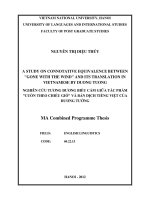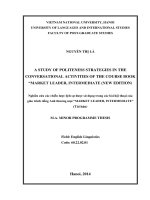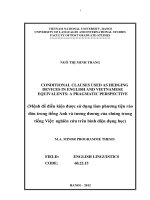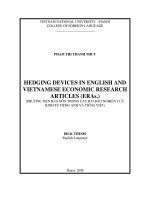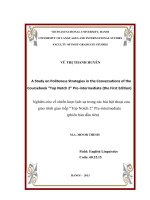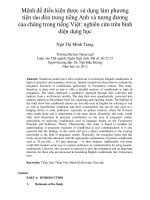Nghiên cứu các phương tiện rào đón trong các cuộc hội thoại của tác phẩm Cuốn theo chiều gió của nhà văn Margaret Mitchell
Bạn đang xem bản rút gọn của tài liệu. Xem và tải ngay bản đầy đủ của tài liệu tại đây (256.46 KB, 15 trang )
Nghiên cứu các phương tiện rào đón trong các
cuộc hội thoại của tác phẩm Cuốn theo chiều
gió của nhà văn Margaret Mitchell
Nguyễn Thị Thanh Huyền
Trường Đại học Ngoại ngữ
Luận văn ThS ngành: Ngôn ngữ Anh; Mã số: 60 22 015
Người hướng dẫn: Assoc. Prof. Dr. Trần Xuân Điệp
Năm bảo vệ: 2012
Abstract: The objectives of the research were to investigate the linguistic devices of
hedges and major pragmatic functions of identified hedges in the conversations in the
novel of Gone with the Wind by Margaret Mitchell. Two levels of linguistic descriptions
– the quantitative and pragmatic analysis mainly based on taxonomy of hedging devices
by Yu (2009) and polypragmatic paradigm of hedges by Hyland (1998) – revealed that
there are four main hedging categories used in the conversations in the novel, namely,
modal hedges, performative hedges, quantificational hedges and pragmatic-marker
hedges, in which quantificational hedges (43.8%) are employed with the highest
frequency, followed by modal hedges (34.8%), performative hedges (8.2%) and other
minor types of tag questions, subjunctives, and depersonalization (5.7%). The research
findings also pointed out that speaker-orientation, accuracy-orientation and hearer-
orientation are three main functions that identified hedging devices fulfill. Among these
types of function, speaker-oriented hedges (48.1%) emerge to be the most prominent,
preceding accuracy-oriented hedges (45.7%) and hearer-oriented hedges (6.2%).
Keywords: Mitchell, Margaret; Tiếng Anh; Hội thoại; Ngôn ngữ
Content
1. Rationale
It is widely accepted that making frictions in human beings’ everyday interaction within a
community is almost inevitable. In order to reduce such a friction and maintain peace and social
harmony, there are certain strategies that should be followed. One of these strategies is
“hedging”.
Introduced for the first time by Lakoff in 1972, the term of “hedge” was generally understood as
“words whose job is to make thing fuzzier or less fuzzy”. Since its appearance, hedges have
received a great deal of attention in conversation analysis where such devices are used to create
conviviality, facilitate discussion, or show politeness (Holmes, 1984; 1995). Hedging has also
been associated with conveying purposive vagueness (Powell, 1985) and as a means of achieving
distance between the speaker and what is said (Skelton, 1997).
Being an interesting linguistic phenomenon, hedges have been concerned by a number of
linguists. However, as a matter of fact, Yu (2009: 34) indicated that the majority of hedge studies
are found to be concerned with academic or scientific writing, including genres such as
economics (Pindi and Bloor, 1986; Channell, 1990), science digests (Fahnestock, 1986), medical
discourse (Salager-Meyer, 1991; 1993; 1994; Adams-Smith, 1984), molecular genetics articles
(Myers, 1989), and news-writing (Zuck & Zuck, 1986; 1987).
The field of spoken discourse, in contrast, seems to receive a comparatively limited number of
comprehensive and thorough investigations. Hence, with the hope of contributing to enrich the
literature of researches on hedging in spoken discourse and to shed some light on the hedging
phenomenon in American everyday conversations by investigating linguistic realization of
hedging, pragmatic functions and some linguistic features of identified hedges, the author of the
present paper decided to carry out the study entitled “A study of hedging devices in
conversations in Gone with the Wind by Margaret Mitchell”. In addition to certain theoretical
contributions, the study is expected to have certain implications in language teaching when
various linguistic expressions would be used to serve as valuable examples for hedging
demonstration at work.
2. Aims of the research and research questions
As mentioned earlier, the present research aimed to investigate linguistic devices of hedging,
their linguistic realization and their major pragmatic functions in conversations in Gone with the
Wind by Margaret Mitchell.
The present study attempts to address the following research questions:
What are main hedging devices employed in conversations in Gone with the Wind by
Margaret Mitchell?
What are major functions of identified hedging devices in conversations in Gone with the
Wind by Margaret Mitchell?
3. Implications of the research
Both theoretical and practical implications may be offered by the findings of the present study.
From the theoretical perspective, this study may serve as an additional source of empirical
studies on hedges in a way that it indicated different types of hedging devices used in everyday
conversations to achieve different pragmatic effects and proved the possibility of utilizing the
combined polypragmatic functions of hedges to investigate hedging phenomenon in spoken
discourse.
In terms of practical perspective, the present study may serve certain samples as a source of
authentic materials in learning and teaching hedging devices and functions of hedges since a
text-based approach is believed to be a key dealing with the lack of pragmatic competence of
non-native speakers in communication with native ones.
4. Scope of the research
First, although communication comes with paralinguistic and extra-linguistic factors, the present
study is restricted to the verbal mode of hedging. That is to say, the prosodic features (speed,
tone, loudness, etc.) and the kinesic mode (facial expressions, eye contact, etc.) are outside the
research scope. Adjacency pairs, in addition, are also beyond the scope of the investigation.
Second, though pragmatic functions of hedging in spoken discourses are believed to be realized
through different communicative strategies without using hedging expressions, such as saying
sorry, showing regret, expressing interest, and so on, the present paper is restrained to linguistic
realization of hedges, from which the pragmatic effects of hedges are expected to be portrayed.
5. Methodology
The research is based on a detailed contextual analysis of conversations in the novel of Gone
with the Wind by Margaret Mitchell. A comprehensive understanding of hedging devices in
Gone with the Wind involves at least two levels of linguistic description: a quantitative analysis
and a pragmatic analysis. The process of analysis is described as follows.
- Quantitative analysis: The purpose of quantitative surface-level analysis is to generalize the
major forms of hedges in conversations. All the indentified items were scrutinized in their
context to select those linguistic categories that express hedges. At this point, the taxonomy
suggested by Yu (2009) was mainly employed to guide the process of identification of
hedging devices in the conversations in the novel.
- Pragmatic analysis: The research then employed a contextual analysis of authentic
conversations at the second level of analysis to identify the purposes served by identified
hedging devices. At this point, the pragmatic analysis was adapted from the theories
introduced by Hyland (1998).
6. Research design
The study is designed to include three main parts.
Part 1: Introduction, presenting the research rationale, aims of the study, research questions,
implications of the research, study scope, methodology and the structure of the paper.
Part 2: Development
Chapter1: Theoretical Background, including definitions of hedge, hedging
taxonomies, relationship between hedges and conversational maxims and politeness
strategies, and general information on Gone with the Wind.
Chapter 2: Findings and Discussions, describing major hedging devices, their linguistic
realization and pragmatic functions in Gone with the Wind.
Part 3: Conclusion, summarizing the major points, limitations, and suggestions for further
studies.
PART 2: DEVELOPMENT
CHAPTER 1
Theoretical Background
1.1. Definitions of hedge
Lakoff (1972: 195), from the point of view of language philosophy, used the term hedge for the
first time to refer to “words whose job is to make things fuzzier or less fuzzy”.
According to Brown & Levinson (1987: 145), hedges are defined as “a particle, word or phrase
that modifies the degree of membership of a predicate or a noun phrase in a set; it says of that
membership that it is partial or true only in certain respects, or that it is more true and complete
than perhaps might be expected”
According to Hyland (1998: 5), hedging is “the means by which writers can present a
proposition as an opinion rather than a fact: items are only hedges in their epistemic sense, and
only when they mark uncertainty”
1.2. Classification of hedging devices and hedging functions
Concerning the classification of hedging devices, it is widely accepted that “the taxonomy of
hedges is rather arbitrary, since there are no unified criteria for the classification of hedges” (Yu,
2009: 55). The following is an overview of some most prominent approaches to classification of
hedges and hedging functions available in the literature.
Hyland’s classification
Hyland (1998: 156) argued that because “hedging devices may convey a range of meanings for
particular users in particular contexts”, they “do not fit into a neat scheme of discrete categories
which allows one meaning to be clearly distinguished from others” and “assigning specific
meaning exclusively to particular forms is not always possible” (Hyland, 1996a: 437). Due to the
polypragmatic nature of hedging devices, he developed a fuzzy category model for hedging
device, in which two main categories were mentioned: content-oriented hedges and reader-
oriented hedges.
Content-oriented hedges, which are further subdivided into accuracy-oriented hedges and
writer-oriented hedges, serve to mitigate the relationship between propositional content and a
non-linguistic mental representation of reality.
The accuracy-oriented hedges, according to Hyland (1998: 164), refer to writer’s desire to
express proposition with greater precision through attribute and reliability hedges. While
attribute hedges, represented by such adverbs as quite, almost, barely, generally, approximately,
etc., help writers to specify more accurately how far their results approximate to an idealized
state, the second subtype, reliability hedges, indicating the amount of writer’s certainty or
uncertainty in a proposition are presented by modal verbs (e.g. can, could, may, might), modal
adjectives (e.g. possible, likely), modal adverbs (e.g. probably, possibly, maybe, apparently) and
modal nouns (e.g. possibility, probability, chance).
As concerns writer-oriented hedges, Hyland (1998: 170) argued that their aim is to shield the
writer from the possible consequences of negatability by limiting personal commitment. Writer-
oriented function of hedge, therefore, can be realized by employing the absence of writer
agentivity, passive constructions, “abstract rhetors”, epistemic lexical verbs with judgmental and
evidential meaning, attribution to the source of claim, which “help to minimize writers’ personal
involvement and allows them to maintain a distance from a proposition” (Hyland, 1998: 171).
Along with accuracy-oriented and writer-oriented hedges, Hyland (1998: 182) also discussed
reader-oriented category of hedges, in which the interpersonal interaction between readers and
writers is mostly dealt with by involving the readers in a dialog and addressing them as a
thoughtful individual to respond and judge regarding the truth value of the proposition.
According to Hyland (1998: 184), personal attribution and reference marked by pronouns such as
I, we, my, our are considered as the main indicators of reader-oriented hedges. Besides the use of
personal pronouns, reader-oriented hedge can be realized through the use of questions, appeals to
testability and suggestions of alternatives.
Yu’s classification
Another approach regarding hedging devices and their functions was proposed by Yu in 2009.
Considering that it is indeed difficult to offer a satisfactory classification of hedging devices
without a careful description of the properties and characteristics of hedging, Yu (2009: 68)
developed a different taxonomy of hedging devices that is based on the grammatical, semantic
and pragmatic properties of hedging devices. He suggested that from the complex interactions
between grammatical, semantic and pragmatic properties of hedging, it can be predicted that
certain linguistic areas are more likely to be the sources of hedging than others (Yu, 2009: 77).
Based on exhaustive literature overview, Yu distinguished four broad hedging categories,
namely modal hedges, performative (mental) hedges, pragmatic-marker hedges, and
quantificational hedges. The category of modal hedges includes modal auxiliary verbs (e.g. may,
might, could, can), modal adjectives (e.g. possible, likely, probable), modal adverbs (e.g.
possibly, perhaps, probably, maybe), modal nouns (e.g. possibility, chance). The category of
mental hedges is generally represented by lexical verbs with epistemic meaning (e.g. think,
suppose, guess, believe, etc). Quantificational hedges encompass those devices that indicate
quantity, frequency and degree (e.g. some, about, nearly, approximately, almost, quite, sort of,
kind of, etc.). Pragmatic-marker hedges (implicit hedges), which are “apparently a feature of oral
rather than written discourse” (Yu, 2009: 93), include such expressions as actually, in fact,
generally speaking, in my opinion, for me, in other words, I suppose, I mean, if you like, you
know, etc.
1.3. About Gone with the Wind by Margaret Mitchell
Gone with the Wind is a romantic drama and the only novel written by Margaret Mitchell. It is
set in Jonesboro and Atlanta, Georgia during the American Civil War (1861 – 1865) and
Reconstruction, and follows the life of Scarlett O'Hara, from the utmost luxury to absolute
starvation and poverty, and from her innocence to her understanding and comprehension of life.
Winning the 1937 Pulitzer Prize, Gone with the Wind has been considered to be one of the most
popular books of all time.
CHAPTER 2
Findings and Discussions
1.1. Analysis of hedging devices in Gone with the Wind
1.1.1. Analysis of modal hedges
Modal auxiliary verbs are the most important category, which alone takes up 75.7% of the total,
leaving the rest only 24.3%. Coming next is modal adverbs, covering 17%, modal adjectives
(6.4%), and epistemic lexical verbs (0.9%). No modal nouns as hedges were found as in the data,
accounting for 0% of the total.
With regards to the first hedging category, modal auxiliary verbs, there is a total of 11 items used
as hedges in the data, in which would contributes 279 (31.1%) of 896 tokens, preceding could
(166 tokens, 18.5%) and wouldn’t/ would not (139 tokens, 15.5%). The prominence of modal
verbs would is to be expected, since it expresses the meaning of epistemic possibility as Hyland
(1998: 111) states the auxiliary would is recognized as the main hypothetical modal with
epistemic meaning, expressing prediction. It is also seen from the table that can’t/ cannot (15
tokens, 1.7%), might not (4 tokens, approximately 0.4%), and may not (3 tokens, roughly 0.3%)
were found to less outstanding in the conversations of the novel. The followings are examples of
would, could and can extracted from the data.
In terms of modal adverbs, the table lists seven items of hedging expressions. It shows that
maybe, with a frequency of 58 out of 201 tokens, or 28.9% of the total, is the most important
device. Perhaps (n = 52) ranks as the second most important. Probably, certainly, and surely
jointly amount to 78 tokens. Other types like possibly and obviously make up just 13%. Some
examples of adverbs as hedges are illustrated as follows.
As concerns modal adjectives, six items with 76 tokens were found in the conversations in the
novel, among which sure accounts for the highest contribution (44.7%), followed by afraid
(25%). There is no difference in the number of likely, impossible, and obvious (n = 6). The final
category identified is possible with 5 tokens, just making up 6.6% of the total.
The category of epistemic lexical verbs is the last category of modal hedges discussed in this
part. A total of two items were recognized, in which seem (n = 10) was found and the rest was
appear (n = 1). It should be mentioned that the number of epistemic verbs used as hedges should
have been more, but it was decided not to include some verbs like suppose, believe, etc. because
they are considered to belong to performative hedges, an independent category of hedging in this
study.
1.1.2. Analysis of performative hedges
There are 16 linguistic items used as hedging devices in the data, in which I think and its
emphasis form I do think were exclusively the most noticeable performative hedges. I think/ I do
think (n = 87) alone account for 31.2% of the total. Ranking at the second position is I suppose
(n = 29), covering 11.1%. The least prominent categories of performative hedges consist of I feel
(1.1%), I feel (1.1%), I say (1.1%), I must tell (0.7%) and I regret (0.7%).
1.1.3. Analysis of quantificational hedges
Four types of quantificational hedges were identified,namely, quantity approximators, frequency
approximators, degree approximators, and “negation + intensifier” approximators. An
pproximate half of quantificational hedges belong to degree approximators (816 tokens, 54.8%).
Another half is quantity approximators (495 tokens, 33.3%), “negation + intensifier”
approximators ( 106 tokens, 7.1%), and frequency approximators (71 tokens, 4.8%).
Specifically, in terms of quantity approximators, there are 10 subtypes in which some/ some of is
the most frequently used to perform hedging functions, making up 45.9%, followed by one of
(11.1%) and many/ many of (10.1%). Abit of and a number of are two final subcategory of
quantificational expressions used as hedges, together covering 1.2% of the total.
With respect to frequency approximators, the table demonstrates six items used in the
conversations of the novel to convey hedging meaning, turning out 71 tokens. Sometimes offers
26 tokens (36.6%) to become the most prominent. The next rank comes often (17 tokens, 23.9%),
hardly (16 tokens, 22.7%). The most moderate number of tokens belongs to occasionally (2.8%).
As with degree approximators, the subtable gives detailed information of degree approximators,
in which nine items functioned as hedging devices with 816 tokens are presented. It can seen that
Just is the most abudant, alone accounting for 51.5%, leaving the rest 49.5%. About is the second
most prominent when covering 29.8%. Partly and sort of were identified to cover only 1% of the
total. Some examples of degree approximators are illustrated as follows.
Finally, with reagrds to “negation + intensifier” approximators, the subtable shows that there are
five items in total with 106 tokens. Not so and its variation contributed 37 tokens, making up
34.9 of the total rate, followed by not much and its variation (20.8%). not too and its variation
offer only 12 items, accounting for 11.3%. Some extracts of “negation + intensifier”
approximators used as hedging expressions from the data are drawn below.
1.1.4. Analysis of pragmatic-marker hedges
In term of interpersonal pragmatic-marker (IPM) hedges which bring about a sense of
cooperation, sharing, intimacy or solidarity between interlocutors and are normally expressed by
consultative, modest or humble attitude in a reduced or weakened tone, they boast five types, in
which Do you think (n = 45) is the most frequently used as hedges, and 105 tokens of the total,
accounting for 41.3%. Interpersonal pragmatic-marker hedges are exemplified by the follows.
In terms of propositional pragmatic-marker (PPM) hedges, the devices, which modify utterance
propositions via correction, elaboration, specification, expansion, or reorientation of
propositional content and working on propositional content (Yu, 2009: 97), are roughly divided
into six subsets. However, it should be mentioned that the division is somewhat random, mainly
for convenience in presentation rather than for theoretical significance
The first subset aims to guard against some misconceptions toward the utterance of the speaker
and provides a frame for the speaker to clarify such misconceptions. Therefore, this subset of
PPM hedges can shield the speaker from some potential false impression and subsequent risks.
There are four types and 58 tokens of this subset.
Subset 2 is a division that signals sort of precondition or prerequisite for the upcoming statement,
implying that the speaker is not committed to the statement. Fallen in this subset are three types
with 30 tokens.
Subset 3 is a group used mainly for explanatory or exemplifying purposes in expressing difficult
issues. In these cases, speakers normally use just like or something like to approximate the target
or to provide a rough idea or a paraphrase of the idea. Three types with 25 tokens were identified
for this subset.
Subset 4 is a division that both signals the speaker’s ground for evaluation or judgment and
indicates the speaker as the source of information. By indicating the speaker as the source of
information, these pragmatic markers may well save face for others. Fallen in this subset are four
types and 23 tokens of PPM hedges.
Subset 5 indicates that the speaker is not the source of information, which helps the speaker
avoid taking responsibility or being proved wrong with his/ her utterances. This subset consists
of three types and four tokens.
The final subset is a group of pragmatic markers serving the purpose of correcting
misconceptions expected of the hearer and providing further explanations for the foregoing
discourse. They come to be used as hedges because further explanations are usually a weaker
version of the foregoing discourse, making it sound more reasonable and substantiated, thus
easier to be accepted by the hearer. Included in this subset were seven types with 12 tokens.
1.1.5. Analysis of tag questions, subjunctives and depersonalization
In terms of subjunctives, there are 10 types used as hedging devices, in which as if (9 tokens,
18.8%), If you were/ weren’t (8 tokens, 16.6%), and as though (8 tokens, 16.6%) were identified
to be the most important expressions serving hedging effect.
As concerns tag questions, the table reveals that there are six types with 124 tokens to make tag
questions become the most prominent category expressing hedging meaning, making up 64.2%.
Tag questions of you such as “didn’t you?”, “have you?” or “are you?” offer 69 tokens,
accounting for 55.6% while there is only one tag question of they acting as a hedging device.
Finally, with regards to depersonalization, the table presents four subtypes employed to convey
hedging effect. There is a total of 21 tokens found in the data, in which the expression It looks/ It
looked alone accounts for 62%, followed by No one can (19%), and the rest (11%).
1.2. Functional analysis of hedging devices in Gone with the Wind
1.2.1. Speaker-oriented function of hedges
Speaker-orientation is the most prominent function that hedging devices perform in the
conversations of the novel. The percentage of 48.1% of the identified hedges was found to be
speaker-focused ones, which aim to shield the speakers from possible consequences of error
when making utterances. The overall prominent position of speaker-oriented hedges in the
corpus suggests that the speakers employ hedging devices primarily for the purpose of protecting
themselves from being proved wrong by limiting their personal commitment. This function of
hedged was also identified to be realized by a variety of hedging categories, such as, modal
auxiliary verbs, epistemic adverbs, epistemic adjectives, epistemic nouns, epistemic lexical
verbs, and depersonalization. All contributed a total of 1561 items functioning as speaker-
oriented hedges.
1.2.2. Accuracy-oriented function of hedges
Ranking at the second important function (45.7%), accuracy-orientation refer to the devices
which show the speaker’s concern to propositions with precision as Coetzer (2002: 57) has
mentioned “accuracy-oriented hedges try to present information as fully, accurately, and
objectively as possible”.
In the data of the research, typical linguistic means to realize this hedging function include
approximators of quantity, frequency, and degree such as some, about, nearly, almost, quite, so
on. In other words, accuracy-oriented function of hedges in the conversations of the novel Gone
with the Wind is fulfilled thanks to quantificational hedges.
It can be concluded that speaker-oriented and accuracy-oriented hedges both concern about the
precision, definiteness, or certainty of the utterance, but it is the focus of hedging that make them
different from each other. While accuracy-oriented hedges focus on modification of words or
phrases within a proposition, like He is sort of sad, the focus of speaker-oriented hedges is given
to the truth-value of the whole proposition and speaker’s commitment or attitude to the content,
like I think he is sad.
1.2.3. Hearer-oriented function of hedges
Hearer-oriented function of hedges, which mostly fulfills interpersonal interaction between
speakers and listeners and “works on syntactic level or utterance level to monitor the
interaction/communication process” (Yu’s, 2009: 105), makes up a relatively small rate (6.2%)
in comparison with the speaker-oriented and accuracy-oriented function.
The data of the present study revealed that this type of function can be realized though various
hedging expressions in making recommendation or suggestions, asking questions, taking
personal responsibility, and addressing readers. In other words, it is interpersonal pragmatic-
marker hedges that perform hearer-oriented function in the conversations of Gone with the Wind.
PART 3: CONCLUSION
1. Recapitulation of main ideas of the research
Two levels of linguistic descriptions which consist of the quantitative analysis, mainly based on
taxonomy of hedging devices Yu’s (2009), and pragmatic analysis, adapted from polypragmatic
paradigm of hedges of Hyland’s (1998) are utilized for the purpose of data analysis. The study
was performed with regards to two following questions:
1. What are main hedging devices employed in conversations in Gone with the Wind by
Margaret Mitchell?
2. What are major functions of identified hedging devices in conversations in Gone with the
Wind by Margaret Mitchell?
In respect to the first questions, the findings of the research showed that there are four main
categories of hedging devices emerging from the data, namely, modal hedges, performative
hedges, quantificational hedges, and pragmatic-marker hedges, in which quantificational hedges
(43.8%) are employed with the highest frequency, followed by modal hedges (34.8%),
performative hedges (8.2%), and other minor types of tag questions, subjunctives, and
depersonalization (5.7%).
Concerning pragmatic functions of hedging expressions raised from the second question, it can
be concluded from the research that hedges perform three types of functions related to: speaker
orientation, accuracy orientation, and hearer orientation. Among these, speaker-oriented hedges
(48.1%) emerge to be the most prominent, preceding accuracy-oriented hedges (45.7%) and
hearer-oriented hedges (6.2%).
2. Limitations of the study
Due to the scope, the study has the following limitations.
The first issue deserving consideration concerns the notion of hedges and taxonomies of hedging
devices. When carrying out the study, in which the taxonomy of hedging devices of Yu (2009)
were employed, the author was fully aware of the fact that there still exist controversial questions
as to what exactly is a hedge and how this phenomenon should be investigated, which make it
impossible to develop a complete taxonomy of hedging devices. Therefore, context-based
analysis and various references from the related literature were employed by the author to deal
with the mentioned issues.
Secondly, when it came to analyze pragmatic functions of hedges in this research, it was
perceived by the author that hedging pragmatic functions might be realized through different
communicative strategies without hedging devices’ existence; however, due to the limited time,
the present paper was restricted to linguistic realization of hedging only, from which the
pragmatic effects of hedges were partly portrayed.
3. Suggestions for further studies
There are issues left untouched in this preliminary research into hedging phenomenon because of
its size and limit. To begin with, although the results of the investigation of hedging phenomenon
in conversations in Gone with the Wind revealed different hedging devices and confirmed the
multi-functional nature of hedges, it is fully realized by the author of the paper that some
communicative strategies could be employed to fulfill hedging functions without using hedging
expressions. Therefore, future researchers are suggested to investigate possible hedging
strategies in the novel to gain a more comprehensive analysis of hedging phenomenon in terms
of linguistic features as well as pragmatic functions.
Secondly, the present study almost cannot take into account prosodic features and paralinguistic
factors which are supposed to be crucial in spoken discourse to highlight their hedging meanings.
The further studies would be better if those factors could have been taken into consideration.
Finally, it is believed that the cultural features of American face-to-face interactions can be
reflected in the way hedging means and hedging strategies are exploited in American everyday
conversations, which deserves in-depth studies in the future.
References
Adams-Smith, D. (1984). Medical discourse: Aspects of author's comment. English for Special
Purposes, 3, 25-36.
Bashanova, E.Y. (2012). Hedging in online news writing. National Taiwan University of Science
and Technology.
Brown, G., & Levinson, S. (1978). Universals in language usage: Politeness phenomena. In E. N.
Goody (Ed.), Questions and politeness: Strategies in social interaction (pp. 56-310).
Cambridge: Cambridge University Press.
Brown, G., & Levinson, S. (1987). Politeness: Some Universals in Language Usage. Cambridge:
Cambridge University Press.
Channell, J. (1990). Precise and vague expressions in writing on economics. In W. Nash (Ed.),
The Writing Scholar: Studies in Academic Discourse. Newbury Park, CA: Sage.
Clemen, G. (1997). The concept of hedging: Origins, approaches and definitions. In R.
Markkanen & H. Schroder (Eds.), Hedging and discourse: approaches to the analysis of a
pragmatic phenomenon in academic texts. Berlin; New York: Walter de Gruyter.
Coates, J. (1988). Women’s Speech, Women Strength? In York Papers in Linguistics 13:
selected papers from the sociolinguistics symposium.
Crompton, P. (1997). Hedging in academic writing: Some theoretical problems. English for
Specific Purposes, 16 (4), 271-287.
Edmondson, W. (1981). Spoken Discourse: A Model for Analysis. London/New York: Longman.
Fahnestock, J. (1986). Accommodating science: The rhetorical life of scientific facts. Written
Communication, 3(3), 275-296.
Fauziyah, N. (2007). The Flouting and Hedging maxims Used by the Main Characters in
William Gibson’s “The Miracle Worker”. English Letters and Language Department, Faculty
of Humanity and Culture, the State Islamic University of Malang.
Fraser, B. (1975). Hedge performatives. In P. Cole & J. L. Morgan (Eds.), Syntax and semantics
(Vol. 3: Speech acts): 187-210. New York: Academic Press.
Fraser, B. (1988). Types of English discourse markers. Acta Linguistica Hungarica, 38, 19-33.
Grice, H.P. (1975). Logic and Conversation. In P. Cole & J. Morgan (eds). Syntax & Semantics
3: Speech Acts. New York: Academic Press, pp. 41 – 58
Holmes, J. (1984). Hedging your bets and sitting on the fence: some evidence for hedges as
support structures. Te Reo, 27, 47-62.
Holmes, J. (1988). Doubt and certainty in ESL textbooks. Applied Linguistics, 9, 20-44. Holmes,
J. (1995). Women, Men, and Politeness. London: Longman.
Holmes, J. (1995). Women, Men, and Politeness. London: Longman.
Hyland, K. (1994). Hedging in academic writing and EAP textbooks. English for Special
Purposes, 13(3), 239-256.
Hyland, K. (1996a). Writing without conviction? Hedging in science research articles. Applied
Linguistics, 17(4), 433-454.
Hyland, K. (1996b). Talking to the academy: Forms of hedging in science research articles.
Written Communication, 13, 251-281.
Hyland, K. (1998). Hedging in scientific research articles. Amsterdam; Philadelphia: John
Benjamins.
Hyland, K., & Milton, J. (1997). Qualification and certainty in L1 and L2 students' writing.
Journal of Second Language Writing, 6(2), 183-205.
Lakoff, G. (1972). Hedges: A study in meaning criteria and the logic of fuzzy concepts. Chicago
Linguistic Society Papers, 8, 183-228. Reprinted as in Lakoff (1973).
Lakoff, G. (1973). Hedges: A study in meaning criteria and the logic of fuzzy concepts. Journal
of Philosophical Logic, 2, 458-508.
Markkanen, R., & Schröder, H. (1997). Hedging: A challenge for pragmatics and discourse
analysis. In Markkanen, R., & Schröder, H. (Eds.). Hedging and discourse: approaches to
the analysis of a pragmatic phenomenon in academic texts. (pp. 3-18). Berlin; New York:
Walter de Gruyter.
Myers, G. (1989). The pragmatics of politeness in scientific articles. Applied Linguistics, 10(1),
1-35.
Myers, G. (1992). Textbooks and the sociology of scientific knowledge. English for Special
Purposes, 11(3-17).
Paloma P. (2007). A contrastive analysis of hedging in English and Spanish architecture project
descriptions. Spanish Journal of Applied Linguistics, 20, 139-158.
Pindi, M., & Bloor, T. (1986). Playing safe with predictions: Hedging, attribution and conditions
in economic forecasting. Written Language, BAAL. 2. CILT.
Powell, M. (1985). Purposive vagueness: An evaluation dimension of vague quantifying
expressions. Journal of Linguistics, 21, 31-50.
Prince, E., Frader, J., & Bosk, C. (1982). On Hedging in physician-phycisian discourse. In R. D.
Pietro (Ed.), Linguistics and the Professions (pp. 83-97). Hillsdale, NJ: Ablex.
Riekkinen, N. (2009). Softening criticism: The use of lexical hedges in academic spoken
interaction. (Unpublished MA Thesis). University of Helsinki. Retrieved August, 1, 2012,
from
Riekkinen, N. (2009). Softening criticism: The use of lexical hedges in academic spoken
interaction. (Unpublished MA Thesis). University of Helsinki. Retrieved August, 1, 2012,
from
Salager-Meyer, F. (1991). Hedging in medical discourse: 1980-1990. Interface, 6(1), 33-54.
Salager-Meyer, F. (1993). Imprecision and vagueness (hedging) in today's medical discourse:
courtesy, coyness or necessity? The ESPecialist, 14(1), 1-15.
Salager-Meyer, F. (1994). Hedges and textual communicative funstion in medical English
written discourse. English for Special Purposes, 13, 149-170.
Skelton, J. (1997). How to tell the truth in The British Medical Journal: Patterns of judgement in
the 19th and 20th Centuries.
Vande Kopple, W. (1985). Some exploratory discourse on metadiscourse. Colleg Composition
and Communication, 36, 82-93.
Varttala, T. (1999). Remarks on the communicative functions of hedging in popular scientific
and specialist research articles on medicine. English for Specific Purposes, 18 (2), 177-200.
Vass, H. (2004). Socio-cognitive aspects of hedging in two legal discourse genres. IB•RICA, 7,
125-141. Retrieved August,1, 2021, from
Wilamová, S. (2005). On Expressing Negative Politeness in English Fictional Discourse. Spisy
filozofické fakulty Ostravské univerzity, Ostrava. Ostravská univerzita.
Yu, S. (2009). The pragmatic development of hedging in EFL learners. Hong Kong University.
Retrieved August, 1, 2012, from
Zuck, J. G., & Zuck, L. V. (1986). Hedging in news writing. In A M. Cornu, J. Van Parjis, M.
Delahaye & L. Baten (Eds.), Beads or bracelets? How do we approach LSP, Selected papers
from the fifth European symposium on LSP (pp. 172-180). Oxford: Oxford University Press.
Zuck, J. G., & Zuck, L. V. (1987). Hedging in newswriting. In A M. Cornu, J. Vanparijs & M.
Delahaye (Eds.), Beads or bracelets: How do we approach LSP? (pp. 171-181). Leuven,
Belgium: Oxford University Press.




